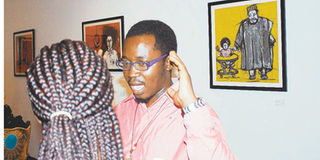Promoting women’s rights with every brush stroke on canvas

Gadi Ramadhani talking to one of the participants at the Giants and Girls Exhibition at oasis Cafe in Masaki, Dar es Salaam. PHOTO | ESTHER KIBAKAYA
What you need to know:
- Like many young artists, his contribution to the industry has grown immensely over time while he continues to spread his positive messages through his art work.
Gadi Ramadhani is a 29-year-old visual artist and curator who lives in Dar es Salaam. born in Kigoma, he started drawing as a child and later went to studyDesign Foundation and Print Making in South Africa.
Like many young artists, his contribution to the industry has grown immensely over time while he continues to spread his positive messages through his art work.
He has also used his voice through arts to touch the lives of many, a good example is one of his exhibition early this week where he criticised child marriage. His artworks were inspired by recent cases in Tanzania regarding the legal age of marriage as he celebrates ten years as a professional artist.
‘It started out when I was in school I remember drawing on the board or during school competitions and receiving gifst. But it went on until when I joined secondary school in Jitegemee where we had classes for students who had various talents, I joined the art class. But I had to stop when I got a chance to go to South Africa for a course in Design Foundation and Printmaking in 2003,”he says.
Upon his return to the country in 2008, he began pursuing art as a career.
“ During my stay in South Africa I mastered some of the drawing techniques including what we call print making. This is one of the oldest painting style that was done back in the days.
In short I was back home having the best knowledge and skills in printmaking following the remarkable success I had with the art style, I am also proud to be among the very few who know about this type of art, ”he states.
He says the years spent in South Africa helped in shaping him. “Being in an art school is a competition itself. While there, I learned not only how to be a content developer but also how to develop the art language focusing more in content because it was an important aspect in art. During tmy studies, I also worked and got paid on various pieces of artwork I created.”
Today he is considered as one of the youngest printmakers across t East Africa region and other parts of the continent. He is also one of the first artist to own a studio at Nafasi Art Space having worked as a director there until early 2013.He still learns every day from event organising , production and content generation.
He says his inspiration comes from daily happenings in the society that he lives in.
“For me art is more than work, it is life so I use art to express whatever makes me or the people around me uncomfortable or bothered be it social or political event. Sometimes the message tends to create mixed feelings especially when it touches a few people’s interests but that does not worry me so long as it brings positive changes to my community,” explains Gadi who is also a fashion designer.
“I am also inspired by what I read, see and hear every day in my life, I am inspired by a lot of people in various ways especially the community, environment and even the street life. How people see things and talk about various issues for instance, corruption, government performance or how politicians are painted in public. In short it’s all about the typical daily life and I use all of these feelings and ideas to portray on my prints or canvas with colours and images so that who ever sees it can become a key changer in his community,” he states.
He admits that art has changed him for better, saying the person he is today is not the same person who came back to Tanzania from in 2008.
“The experience I have acquired all these years is immense .It has opened doors for many opportunities not only inside my country but outside the country as well. I receive invitations to go to other countries when they have their events to go and organise and supervise, that is a big step,’’ he says.
He is a firm believer in empowering girls saying woman have been left behind on a number of issues.
“We are witnessing how families put boys first when they are to make decisions when certain opportunities arise in the family. They give first priority to their son as they believe if he becomes successful he will help the family, but they are forget that he too will marry and put his priority to his family first unlike a girl who they think can’t be of help to the family,” he states.
He went further saying he doesn’t want to continue seeing girls and women being left behind.
“And the research I have done shows that uncles have been mostly responsible in marrying off young girls in their families, girls who have lost their fathers and are under the care of their guardians are also affected,’ he says.
Talking about the welfare of Tanzanian artists, he says our country don’t have a precise system when it comes to art.
“Many artist are paying fees to Basata though I doubt if there is any artist who has ever received an email from them with an annual report explaining how their money has been used,” he states.
“Our country needs to initiate things that will boost our artists to do better, there is an illegal selling of artists’ works outside the country. We also wait until a certain artist dies then we start looking for his the work he left behind. Artwork shouldbe taken as national treasure,” he says.
He enjoys reading books and he loves cooking during his free time.
Email: [email protected]




